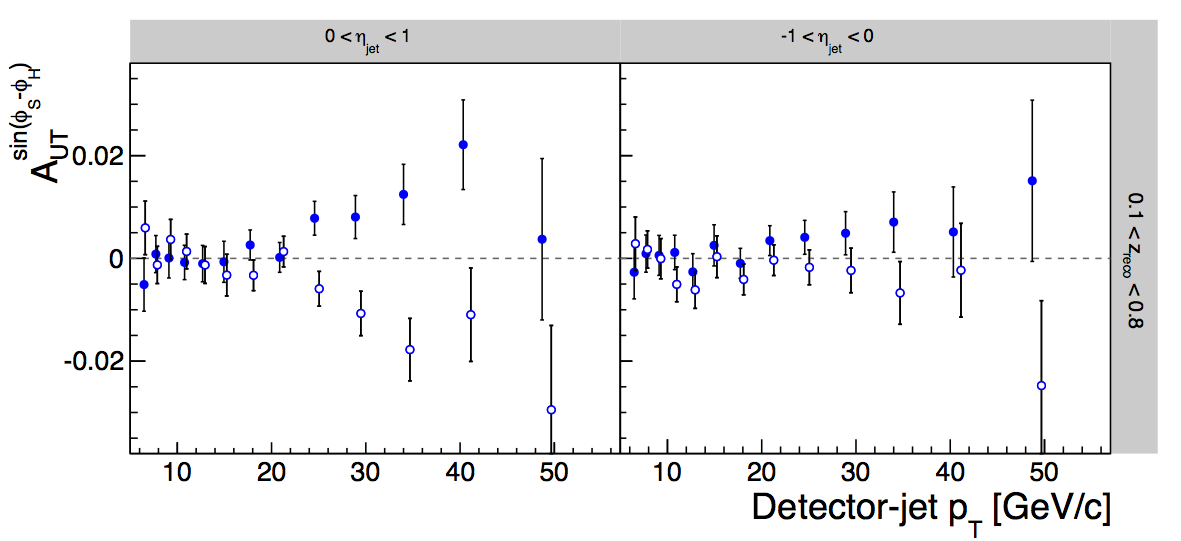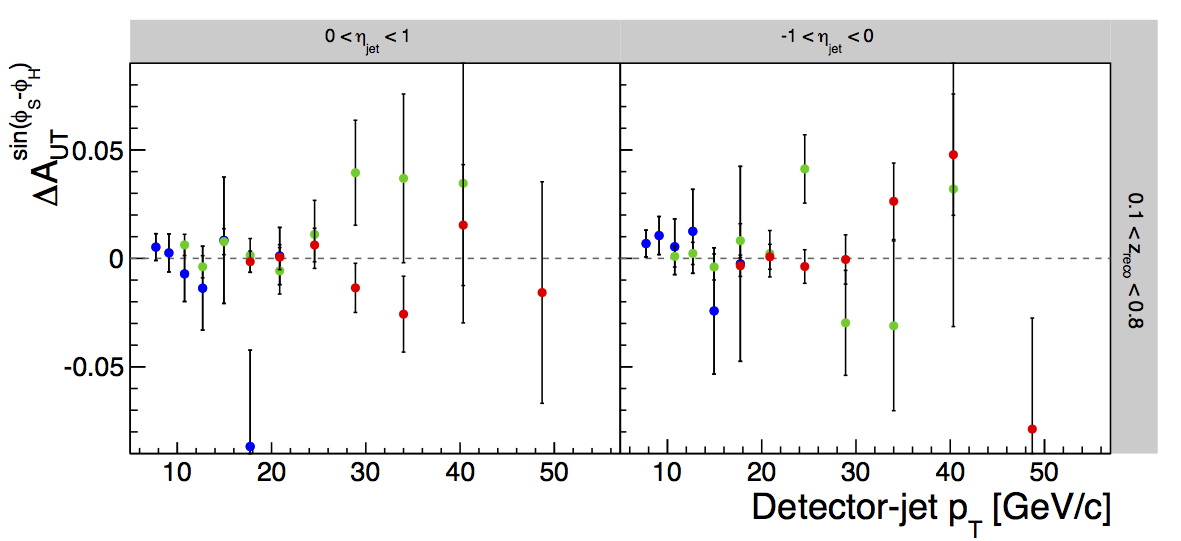- drach09's home page
- Posts
- 2022
- 2020
- June (1)
- 2019
- 2018
- 2017
- 2016
- 2015
- 2014
- December (13)
- November (2)
- October (5)
- September (2)
- August (8)
- July (9)
- June (7)
- May (5)
- April (4)
- March (4)
- February (1)
- January (2)
- 2013
- December (2)
- November (8)
- October (5)
- September (12)
- August (5)
- July (2)
- June (3)
- May (4)
- April (8)
- March (10)
- February (9)
- January (11)
- 2012
- 2011
- October (1)
- My blog
- Post new blog entry
- All blogs
Run-11 Transverse Jets: Revisiting Trigger Bias
One of the last remaining tasks prior to publication is to revisit trigger bias for the new set of cuts. To this point, I have been using essentially what had been estimated for the preliminary result. The first obvious check is to look at possible trigger-dependence of the new Collins result. To get the best possible precision, I look at the pT-dependence integrated over pion z. I plot the asymmetries at the detector-jet pT, since I have not calculated the proper pT-shifts. Also, this allows easier comparison to the hadrware trigger thresholds.
Effect of Trigger
As mentioned several times on my blog and documented in Pibero's 2009 inclusive jet analysis note, the effect of the trigger with fixed jet patches is a higher efficiency for well-collimated jets. In general, at fixed pT, quark jets are more collimated than gluon jets. Thus, at kinematics where jets are not well collimated, the trigger is expected to have better efficiency for quark jets than for gluon jets.
Trigger Bias in the Collins Effect
Since the Collins effect is quark-specific, one expects that the trigger bias will manifest as an enhancement in the magnitude of the asymmetry measured with biased triggers relative to those measured with unbiased triggers. For calculations of "Biased-Unbiased" the effect should be positive for π+ and negative for π-. Since it is also expected that the magnitude of each effect should be the same with opposite sign, I have combined the two charge states, flipping the sign of the π- differences. Thus, the sign of trigger bias should be a positive deviation from zero.
Figure 1


In Fig. 1 I look at the difference in Collins asymmetries as calculated by the various triggers: JP0-VPDMB in blue, JP1-JP0 in green, and JP2-JP1 in red. A few quick benchmarks:
- Trigger thresholds: JP0 = 32 (6.4 Gev), JP1 = 43 (9.0 GeV), JP2 = 64 (13.9 GeV)
- Asymmetry turn-on: pT,jet ≈ 25 GeV/c
- In 200 GeV, Pibero found biases of 1-2% for pT > 20 GeV/c with trigger threshold of 36 (7.3 GeV)
Since no asymmetry is observed below 25 GeV/c, the Collins measurement is not expected to be sensitive to trigger bias effects. If I fit constants across the range of the large asymmetries (22-55 GeV/c) I find the following:
For JP1-JP0
**************************************** Minimizer is Linear Chi2 = 1.19086 NDf = 3 p0 = 0.0217502 +/- 0.0122458
and for JP2-JP1
**************************************** Minimizer is Linear Chi2 = 4.44854 NDf = 4 p0 = -0.00248477 +/- 0.00583111
Thus, the shift from JP0 to JP1 shows a 1.8σ deviation from zero while the shift from JP1 to JP2 is within 0.5σ of zero and with the wrong sign for trigger bias. I would naïvely expect the largest shifts to be in the comparison of JP2 to JP1, where we observe no trigger effects at the level of 0.006. This assumes that JP1 is basically unbiased at 25 GeV/c and provides a good standard of comparison for JP2. Pibero's studies suggest that the bias in JP1 is very small by 25 GeV/c, however, this is based on 200 GeV studies with a trigger threshold slightly below that for my JP1.
- drach09's blog
- Login or register to post comments
